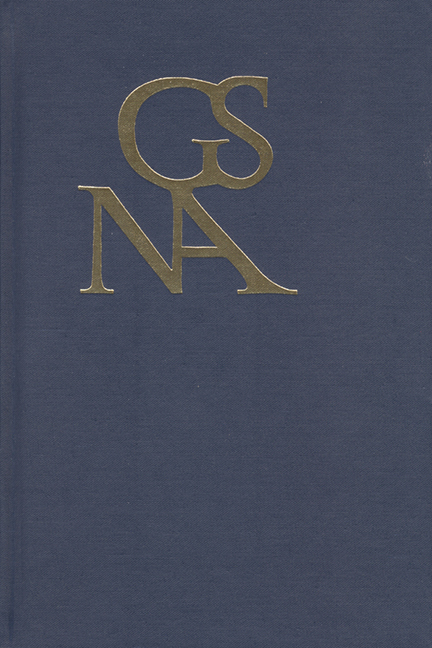Book contents
- Frontmatter
- Contents
- Reorientations around Goethe
- Reorientations around Goethe II
- Special Section on Goethe's Narrative Events edited by Fritz Breithaupt
- What Is an Event for Goethe?
- Much Ado about Nothing? The Absence of Events in Die Wahlverwandtschaften
- Countering Catastrophe: Goethe's Novelle in the Aftershock of Heinrich von Kleist
- Narrating (against) the Uncanny: Goethe's “Ballade” versus Hoffmann's Der Sandmann
- Remembering Klopstock's Mitausdruck
- Strategic Indecision: Gender and Bureaucracy in Schiller's Maria Stuart
- The Dark Green in the Early Anthropocene: Goethe's Plants in Versuch die Metamorphose der Pflanzen zu erklären and Triumph der Empfindsamkeit
- Abschlussbewegungen: Goethe, Freud, and Spectral Forms of Life
- Ein Mythos und sein doppelter Entzug des Modernen: Prämissen für einen Ausweg aus der Unübersichtlichkeit der Faustforschung
- Johann Wolfgang von Goethe in Conversation with Things
- World Literature Turns Political, 1835/36: The Early Afterlife of Goethe's Pronouncement in German Cultural-Politics and in the Young Germany Movement
- Fritz Strich and the Dilemmas of World Literature Today
- A Jewish Faust Commentary: Notes on Franz Rosenzweig's The Star of Redemption
- From Idylle to idílio: Mário de Andrade's Parody of Hermann und Dorothea
- Koselleck's Timely Goethe?
- Book Reviews
Abschlussbewegungen: Goethe, Freud, and Spectral Forms of Life
from Special Section on Goethe's Narrative Events edited by Fritz Breithaupt
Published online by Cambridge University Press: 26 June 2019
- Frontmatter
- Contents
- Reorientations around Goethe
- Reorientations around Goethe II
- Special Section on Goethe's Narrative Events edited by Fritz Breithaupt
- What Is an Event for Goethe?
- Much Ado about Nothing? The Absence of Events in Die Wahlverwandtschaften
- Countering Catastrophe: Goethe's Novelle in the Aftershock of Heinrich von Kleist
- Narrating (against) the Uncanny: Goethe's “Ballade” versus Hoffmann's Der Sandmann
- Remembering Klopstock's Mitausdruck
- Strategic Indecision: Gender and Bureaucracy in Schiller's Maria Stuart
- The Dark Green in the Early Anthropocene: Goethe's Plants in Versuch die Metamorphose der Pflanzen zu erklären and Triumph der Empfindsamkeit
- Abschlussbewegungen: Goethe, Freud, and Spectral Forms of Life
- Ein Mythos und sein doppelter Entzug des Modernen: Prämissen für einen Ausweg aus der Unübersichtlichkeit der Faustforschung
- Johann Wolfgang von Goethe in Conversation with Things
- World Literature Turns Political, 1835/36: The Early Afterlife of Goethe's Pronouncement in German Cultural-Politics and in the Young Germany Movement
- Fritz Strich and the Dilemmas of World Literature Today
- A Jewish Faust Commentary: Notes on Franz Rosenzweig's The Star of Redemption
- From Idylle to idílio: Mário de Andrade's Parody of Hermann und Dorothea
- Koselleck's Timely Goethe?
- Book Reviews
Summary
ON JUNE 21, 1831—less than a year before his death on March 22, 1832— Goethe writes to his friend and fellow botanist E. H. F. Meyer, “Daß ich nahe am Ende meiner Laufbahn noch von dem Strudel der Spiraltendenz ergriffen werden sollte, war auch ein wunderlich Geschick” (LA 1.4:251; That I, at the end of my life, should still be seized by the vortex of the spiral tendency, was also a wondrous fate). Here Goethe alludes to his discovery late in life of a “Spiraltendenz” (spiral tendency) said to inhere in all plants, a claim that he first put forth in his late essay “Über die Spiraltendenz der Vegetation” (1830– 31; “The Spiral Tendency of Vegetation”). In the introduction to that text he asserts: “Wir mußten annehmen: es walte in der Vegetation eine allgemeine Spiraltendenz, wodurch, in Verbindung mit dem vertikalen Streben, aller Bau, jede Bildung der Pflanzen, nach dem Gesetze der Metamorphose vollbracht wird” (FA 24:777; We must assume that a universal spiral tendency presides in vegetation through which, in connection with vertical striving, every structure, every formation of plants, is realized according to the laws of metamorphosis).
Although Goethe insists that his new theory of the spiral tendency ought to be understood as conforming to and buttressing his first published treatise on plant metamorphosis from 1790, his letters, notes, and journal entries attest to the profound difficulties he encountered in bringing this later discovery into harmony with his earlier botanical theory. In light of this unacknowledged problematic in his published scientific writings, I would like to begin this article by delving further into Goethe's fascination with the spiral in order to show how his revisions to the theory of metamorphosis some forty years later call into question the viability of key aspects of his morphological method. More specifically, while numerous scholars have persuasively argued that Goethe's initial treatise on the metamorphosis of plants is grounded in a method of “anschauende Urteilskraft” (intuitive judgment), which depends on the morphologist's ability to unite the “Geistes-Augen” (eyes of the mind) with the “Augen des Leibes” (FA 24:432; eyes of the body),` scant attention has been paid to the problems introduced by Goethe's later theory of the spiral tendency, which resists such ocular dissection.
- Type
- Chapter
- Information
- Goethe Yearbook 26Publications of the Goethe Society of North America, pp. 163 - 178Publisher: Boydell & BrewerPrint publication year: 2019

